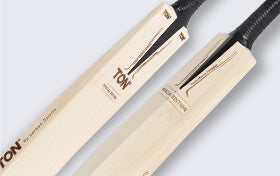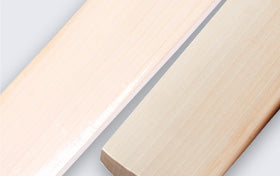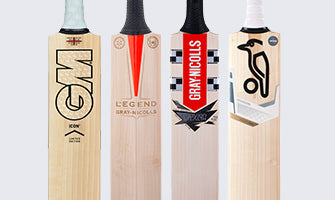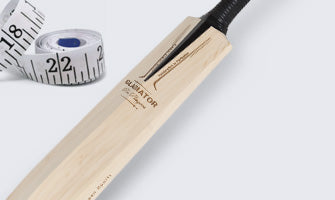When purchasing a new cricket bat there are several factors you need to consider before you spend your money, so you know exactly what you’re getting. In order to avoid being left disappointed, its best to be knowledgeable about what to expect from your cricket bat. This Cricket bat guide is essential for all those who do not fully understand the different features, qualities, materials and services available. So, this guide has been created to help educate and give our customers to make the most effective decision when buying a cricket bat.
PRE-CONDITIONED/PRE-PREPARED BATS

The majority of bat manufacturers have developed several different types of pre-conditioned or pre-prepared bats, which help majorly with cutting down the time the customer has to prepare their bat themselves. Despite this, many bats claim to be ‘match-ready’. We strongly advise that you carry out the usual knocking-in process in order to prepare your bat before going out in the middle – it is still the user’s responsibility to prepare their bat for match situations. (Beware: 'ready to play' does not mean invincible - you should still maintain, store and repair your cricket bat appropriately).
ANTI-SCUFF PROTECTED & COVERED BATS

Most Cricket Specialists recommend fitting a clear ‘anti-scuff’ sheet to the front face of the cricket bat to help minimise the effects of minor knocks to the bat. Once fitted the ‘anti-scuff’ sheet, it will not affect the performance of the bat and will only help prolong a bat’s life span. Anti-scuff sheets offer binding qualities to small cracks while safeguarding the blade from additional moisture being absorbed into the bat.
NATURAL FINISH

The majority of professional-quality cricket bats offer a natural, uncovered, traditional finish. But please be wary that some bats made from poor quality willow may be bleached to artificially imitate the colour of high-quality willow. Always be sure of the type of bat and the specification you are purchasing.
FIBRE TAPE

For self-repairing minor cracks, wood glue and fibre tape are the best materials to help with that. Fibre tape gently helps to bind the damaged area and is an essential yet forgettable item for the cricketer’s kit bag.
NUMBER OF GRAINS

A cricket bat with between 6 and 12 grains tends to be made from a high-quality willow; however, note that this should only be considered as a rough guideline as there are always exceptions. Bats with only 6 grains tend to be softer, resulting in more of a lengthened knocking-in time and time for the bat to reach its optimal performance.
WILLOW-LOOK SKIN

When looking at the grains on the face of the bat, you may sometimes see that low-cost cricket bats have a willow-like skin placed over the face of the bat. This is designed to give the user a false sense of getting a better bat than actually bought. You may be able to spot this by noticing that the natural back of the bat has a very different grain pattern than the front of the bat where the skin is applied.

English Willow cricket bats have a variation in quality due to the different grades of Willow manufacturers use. Due to the vast amount of expertise required to turn a willow sapling into a tree suitable for cricket bat production, there are only a small collection of UK companies who have the skillset to nurture English Willow for the entire world market.
Here is a guideline on how to judge the value of your blade:
Grade 1+ or Grade A is the highest quality of English Willow, typically used by international stars but increasingly available through limited edition cricket bats for the general public. The grains will be straight, even and of a healthy number while any knots, blemishes and markings should be minimal. These grade bats are extremely high-quality and Test match standard.
After Grade 1+/A, you descend to Grade 1, which is still an impressively high-quality bat. Then Grade 2 (B), Grade 3 (C) and Grade 4. As you go lower in quality of bat, you will see more discolouration and markings, with the grains being more irregular, wobbly and plentiful. Grade 4 bats are more likely to be bleached, non-oiled and fixed with an anti-scuff sheet as standard.
A rough indicator of quality of the grade of bats is:
G1+: Test match standard
G1: Professional standard
G2: Top club standard
G3: Lower-league standard
G4: Beginner standard
Despite this, if you want to maximise your potential and reach maximum performance then you should by the highest quality bat you feel is within your budget for a cricket bat.
Other Materials: The handle of a cricket bat, which is usually covered by a plastic grip, is made from cane and connected to the blade via a splice.

English willow style cricket bats can also be nurtured abroad, but due to inferior moisture levels and soil conditions for producing willow clefts, they are not as highly sought after as genuine English Willow.
Kashmir Willow is grown in the Kashmir region of Pakistan and India. It is a very cost-effective material for manufacturers in those nations. Kashmir willow makes the bats often drier, harder and browner than English Willow equivalents, which therefore impacts on durability. Kashmir Willow lacks the resilience of English Willow as well as not having as good a sweet spot. As a result of that, Kashmir Willow tends to be used in lower end bats Adult and Junior Bats.

This is all down to personal preference. Batting manufacturers have responded to the requirements of the modern game by producing a range of bats that have a thick edge and large bow, which helps maximise power without compromising on a light pick-up.
If you enjoy playing off the front foot then a good choice of bat to get would be with a low sweet spot. English wickets keep low, thus why many English cricketers often go for a bat with a low sweet spot. In contrast, in Australia, the pitches are renown for being hard, bouncy surfaces, so a bat with a higher sweet spot is often their preferred choice.
We believe it is well worth picking up a bat and imitating your usual pick-up routine before committing to purchase. Check whether it is light or too heavy. Whether it feels bottom-heavy with a low sweet spot. If a bat is difficult to hold out straight in front of you with one hand then it is probably too heavy.
If you’re an experienced cricketer then you can easily pick up whether a light or heavy cricket bat is right for you. Even if you go for a heavy bat, you are still likely to want a light pick-up. If you are new to the game we recommend using a bat with a lighter pick-up, so that you can play back-foot shots and front-foot shot with equal ease. For example, the cut or pull shot is difficult to play with heavy bat.
TOE GUARD

The toe is the weakest part of the bat so it's best to protect it as much as possible by applying a toe guard. If the bat is struck with a 'Yorker' - a delivery that attacks the very bottom of the batsman's bat - then it is likely to cause damage, but a toe guard could help to minimise the risk of the wood splitting. Toe guards also help to reduce the shock of a batsman tapping his bat on the ground and decreases the amount of moisture that will seep through the toe of the cricket bat in damp conditions.
THE HANDLE

Most senior batsmen will opt for a short handle to allow for greater control of your blade, but if you are above 6 foot 2 inches then a long handle bat is a good option - although, again, it comes down to personal choice. Sizes of junior cricket bats usually range from size 1 (smallest; although occasionally you'll find a size 0) to size 6 (largest), with 'Harrow' being the intermediary size between size 6 and adult short-handle.
Cricket bats are fragile - just because you've spent spent £300-plus on a cricket bat does not mean that it will last forever, nor does it mean that you can mistreat it and still expect your bat to perform at its maximum capability. There are many precautionary measures and maintenance processes you should carry out on your bat, not just prior to first usage but also regularly thereafter. The main measures include knocking-in after purchase, oiling, storing in a cool, dry place and other protection techniques.
For more information, we strongly recommend that you view out Bat Care Guide.
It is important that when purchasing a cricket bat you understand the following:
- There is no guarantee how long it will last even if it is a top-range bat
- A cricket bat needs constant TLC
- The likeliness of cracks are dependent on a number of factors, including luck

Manufacturing flaws are very rare and most damages occur due to poor quality cricket balls, the ball hitting a weak area of the bat, tapping the bat on hard ground or just sheer bad luck. Your cricket bat requires regular upkeep to minimise the chances of severe damage. You will need to patiently knock the bat in and you may even wish to add an anti-scuff covering.
Sometimes the consumer is protected against normal wear and tear in the first twelve months, when it is unlikely that the customer will be charged. However, major damage inflicted by a player who has misused or mistreated the bat, and where no material flaw or structural damage is present in the bat or timber, a repair fee is likely to be incurred.
Do not fret if your new cricket bat starts to sustain cracks. Don't forget they are made out of wood and a hard cricket ball has every chance of scarring and damaging your bat at some stage - even during your first training session.
Also, don't panic if your new cricket bat arrives with knots and blemishes - this is the nature of the material. If you've purchased a mid-to-low standard bat then knots, marks and wobbly grains are likely.
You may wish to view our Cricket Bat Return Guidelines or Delivery & Returns policy.
WE HOPE WE'VE HELPED
If you still have more questions about cricket bats that we haven't covered then please feel free to send us an email: info@cricketdirect.com
We really hope that these cricket bat guidelines have made you more aware of what to look for in a potential cricket bat purchase and that you can proceed with the required knowledge to make an educated decision.
Now you understand the risks, required maintenance, materials and the differing qualities, services and features available for cricket bats, we strongly advise that you take advantage of our unrivalled collection of high quality cricket gear at affordable prices.
Ready To Purchase a Cricket Bat































